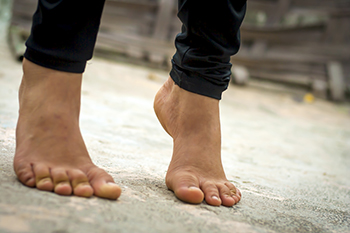Copyright © Michigan Foot and Ankle | Site Map | Nondiscrimination Policy | Design by: Podiatry Content Connection
September 2022
Exercises Can Help Strengthen the Feet

Taking care of the feet is something that often gets overlooked, even though we depend on them so much each day. Good foot health includes exercises that help to strengthen the feet. Starting with toe exercises, stand with your feet a comfortable distance apart. Lift the big toe on one foot while keeping the others down. Then try the opposite, leaving the big toe down and lifting the others. If you tend to pronate, rolling to the inner arch, you may have trouble lifting the big toe, and if you supinate, rolling onto the outer foot, lifting the smaller toes may be difficult. Switch feet. You can also work on strengthening the feet with heel raises. Lift the heels slowly, in order to feel the muscles working, and then lower them slowly. You may wish to hold lightly onto a chair back or wall for balance. This can be timed with breathing in and out. For more information on how to strengthen your feet through exercise, please visit a podiatrist.
Exercising your feet regularly with the proper foot wear is a great way to prevent injuries and build strength. If you have any concerns about your feet, contact one of our podiatrists from Michigan Foot and Ankle. Our doctors can provide the care you need to keep you pain-free and on your feet.
Exercise for Your Feet
Exercise for your feet can help you gain strength, mobility and flexibility in your feet. They say that strengthening your feet can be just as rewarding as strengthening another part of the body. Your feet are very important, and we often forget about them in our daily tasks. But it is because of our feet that are we able to get going and do what we need to. For those of us fortunate enough to not have any foot problems, it is an important gesture to take care of them to ensure good health in the long run.
Some foot health exercises can include ankle pumps, tip-toeing, toe rises, lifting off the floor doing reps and sets, and flexing the toes. It is best to speak with Our doctors to determine an appropriate regimen for your needs. Everyone’s needs and bodies are different, and the activities required to maintain strength in the feet vary from individual to individual.
Once you get into a routine of doing regular exercise, you may notice a difference in your feet and how strong they may become.
If you have any questions please feel free to contact one of our offices located in Ferndale, and Milford, MI . We offer the newest diagnostic and treatment technologies for all your foot and ankle needs.
Do I Have an Ankle Fracture?

An ankle fracture means that one or more of the medial, lateral, or posterior malleolus (the bony projections on either side of the ankle) is broken. Dislocation of the ankle joint can result from an ankle fracture. Usually, when a patient breaks an ankle, they will experience pain, swelling, and an inability to bear weight on the affected foot. There may be a pop when the ankle breaks, and it may appear deformed. Those with osteoporosis, a history of frequent falls, or a compromised vascular system are more at risk for ankle fractures, as are those who have frequently participated in sports. An X-ray, CT scan, or MRI will confirm a broken ankle diagnosis. If you think you have broken your ankle, it is suggested that you see a podiatrist who can recommend the best treatment options for you.
Broken ankles need immediate treatment. If you are seeking treatment, contact one of our podiatrists from Michigan Foot and Ankle. Our doctors can provide the care you need to keep you pain-free and on your feet.
Broken Ankles
A broken ankle is experienced when a person fractures their tibia or fibula in the lower leg and ankle area. Both of these bones are attached at the bottom of the leg and combine to form what we know to be our ankle.
When a physician is referring to a break of the ankle, he or she is usually referring to a break in the area where the tibia and fibula are joined to create our ankle joint. Ankles are more prone to fractures because the ankle is an area that suffers a lot of pressure and stress. There are some obvious signs when a person experiences a fractured ankle, and the following symptoms may be present.
Symptoms of a Fractured Ankle
- Excessive pain when the area is touched or when any pressure is placed on the ankle
- Swelling around the area
- Bruising of the area
- Area appears to be deformed
If you suspect an ankle fracture, it is recommended to seek treatment as soon as possible. The sooner you have your podiatrist diagnose the fracture, the quicker you’ll be on the way towards recovery.
If you have any questions, please feel free to contact one of our offices located in Ferndale, and Milford, MI . We offer the newest diagnostic and treatment technologies for all your foot care needs.
Why The Feet May Become Swollen

There are several reasons why swollen feet can occur. Many people who have sustained a foot injury can have swollen feet and this may be part of the healing process. When fluid is trapped in the body’s tissues it is known as edema. This can affect the feet and the skin may stretch or appear shiny. A limited range of motion in the ankles can also occur. Mild relief may come from frequently elevating the feet and reducing salt intake. Many pregnant women experience swollen feet, and this can be a result of the added weight the body endures due to the fetus and additional fluids. Swollen feet may be common among people who are overweight and lead a sedentary lifestyle. It is beneficial to implement a gentle exercise routine as well as wear shoes that fit well as this can help to alleviate swollen feet. If you have this condition, please confer with a podiatrist who can determine the cause of your swollen feet and provide remedies to help you.
Swollen feet can be a sign of an underlying condition. If you have any concerns, contact one of our podiatrists of Michigan Foot and Ankle. Our doctors can provide the care you need to keep you pain-free and on your feet.
Swollen feet are a common ailment among pregnant women and people who stand or sit for extended periods. Aging may increase the possibility of swollen feet and patients who are obese often notice when their feet are swelling too. There may be medical reasons why swollen feet occur:
- Phlebitis - A condition that causes the veins to become inflamed and can also cause leg pain.
- Liver disease - This may lead to low blood levels of albumin which is a protein. This can cause fluid in the blood to pass into the tissues and several areas of the body can become swollen.
- Heart failure - When the heart doesn’t pump properly the blood that is normally pumped back to the heart can pool in the veins of the legs causing swollen feet.
- Kidney disease - One of the main functions of the kidneys is releasing excess fluid in the body. This type of condition can make it difficult for the kidneys to function properly, and as a result the feet may become swollen.
- Deep-vein thrombosis (DVT)- This is a serious condition where blood clots form in the veins of the legs. They can block the return of blood from the legs to the heart which may cause the feet to swell. It is important to be treated by a podiatrist if this condition is present.
Swollen feet can also be caused by bone and tendon conditions, including fractures, arthritis, and tendinitis. Additionally, there may be skin and toenail conditions and an infection may cause the feet to swell. Patients who take medicine to treat high blood pressure may be prone to getting swollen feet.
Many patients elevate their feet to help relieve the swelling and this is generally a temporary remedy. When a podiatrist is consulted the reason behind the swelling can be uncovered and subsequently treated.
If you have any questions please feel free to contact one of our offices located in Ferndale, and Milford, MI . We offer the newest diagnostic tools and technology to treat your foot and ankle needs.
Are Bunions Affecting Your Everyday Life?
Treating Toenail Fungus

Onychomycosis, also called tinea unguium, is a fungal infection affecting the nails. Fungi thrive in warm, moist environments which can cause them to overpopulate. The same fungi that cause jock itch, athlete’s foot, and ringworm can cause nail infections. Such an infection might present itself as yellow or white spots on the toenail, the nail may raise from the nail bed, the skin surrounding the affected toenail may darken, the nail can become brittle and thick, and there may be a foul odor. Complications can arise from toenail fungus, so early intervention is suggested. Toenail fungus is contagious as well. It can spread between nails, onto the skin, and to other people. If you have any of these symptoms, see a podiatrist for a proper diagnosis. Fungal infections can mimic symptoms of other conditions. Once confirmed, a podiatrist will be able to recommend treatment for your specific toenail issue.
For more information about treatment, contact one of our podiatrists of Michigan Foot and Ankle. Our doctors can provide the care you need to keep you pain-free and on your feet.
Toenail Fungus Treatment
Toenail fungus is a condition that affects many people and can be especially hard to get rid of. Fortunately, there are several methods to go about treating and avoiding it.
Antifungals & Deterrence
Oral antifungal medicine has been shown to be effective in many cases. It is important to consult with a podiatrist to determine the proper regiment for you, or potentially explore other options.
Applying foot powder on the feet and shoes helps keep the feet free of moisture and sweat.
Sandals or open toed shoes – Wearing these will allow air movement and help keep feet dry. They also expose your feet to light, which fungus cannot tolerate. Socks with moisture wicking material also help as well.
If you have any questions please feel free to contact one of our offices located in Ferndale, and Milford, MI . We offer the newest diagnostic tools and technology to treat your foot and ankle needs.







